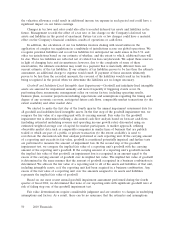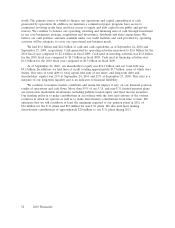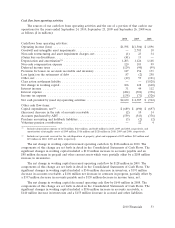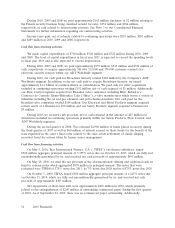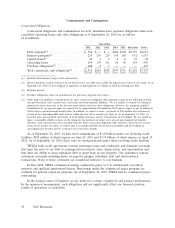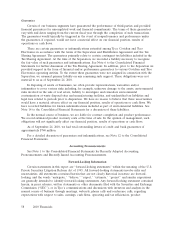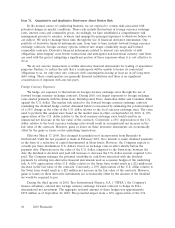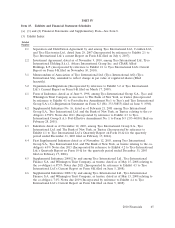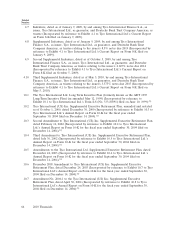ADT 2010 Annual Report Download - page 148
Download and view the complete annual report
Please find page 148 of the 2010 ADT annual report below. You can navigate through the pages in the report by either clicking on the pages listed below, or by using the keyword search tool below to find specific information within the annual report.Item 7A. Quantitative and Qualitative Disclosures About Market Risk
In the normal course of conducting business, we are exposed to certain risks associated with
potential changes in market conditions. These risks include fluctuations in foreign currency exchange
rates, interest rates and commodity prices. Accordingly, we have established a comprehensive risk
management process to monitor, evaluate and manage the principal exposures to which we believe we
are subject. We seek to manage these risks through the use of financial derivative instruments. Our
portfolio of derivative financial instruments may, from time to time, include forward foreign currency
exchange contracts, foreign currency options, interest rate swaps, commodity swaps and forward
commodity contracts. Derivative financial instruments related to interest rate sensitivity of debt
obligations, intercompany cross border transactions and anticipated non-functional currency cash flows
are used with the goal of mitigating a significant portion of these exposures when it is cost effective to
do so.
We do not execute transactions or utilize derivative financial instruments for trading or speculative
purposes. Further, to reduce the risk that a counterparty will be unable to honor its contractual
obligations to us, we only enter into contracts with counterparties having at least an A-/A3 long-term
debt rating. These counterparties are generally financial institutions and there is no significant
concentration of exposure with any one party.
Foreign Currency Exposures
We hedge our exposure to fluctuations in foreign currency exchange rates through the use of
forward foreign currency exchange contracts. During 2010, our largest exposures to foreign exchange
rates existed primarily with the Swiss franc, British pound, Euro, Australian dollar and Canadian dollar
against the U.S. dollar. The market risk related to the forward foreign currency exchange contracts
(excluding the dividend hedge contract discussed below) is measured by estimating the potential impact
of a 10% change in the value of the U.S. dollar relative to the local currency exchange rates. The rates
used to perform this analysis were based on the market rates in effect on September 24, 2010. A 10%
appreciation of the U.S. dollar relative to the local currency exchange rates would result in an
immaterial net decrease in the fair value of the contracts. Conversely, a 10% depreciation of the U.S.
dollar relative to the local currency exchange rates would result in an immaterial net increase in the
fair value of the contracts. However, gains or losses on these derivative instruments are economically
offset by the gains or losses on the underlying transactions.
Effective March 17, 2009, Tyco changed its jurisdiction of incorporation from Bermuda to
Switzerland. Until the last payment is made in February 2011, Tyco intends to make dividend payments
in the form of a reduction of capital denominated in Swiss francs. However, the Company expects to
actually pay these dividends in U.S. dollars, based on exchange rates in effect shortly before the
payment date. Fluctuations in the value of the U.S. dollar compared to the Swiss franc between the
date the dividend is declared and paid will increase or decrease the U.S. dollar amount required to be
paid. The Company manages the potential variability in cash flows associated with the dividend
payments by entering into derivative financial instruments used as economic hedges of the underlying
risk. A 10% appreciation of the U.S. dollar relative to the Swiss franc would result in a $21 million net
decrease in the fair value of the contracts. Conversely, a 10% depreciation of the U.S. dollar relative to
the Swiss franc would result in a $25 million net increase in the fair value of the contracts. However,
gains or losses on these derivative instruments are economically offset by the amount of the dividend
we would be required to pay.
During the third quarter of 2010, Tyco International Finance, S.A. (‘‘TIFSA’’), the Company’s
finance subsidiary, entered into foreign currency exchange forward contracts to hedge its Euro
denominated net investment. The aggregate notional amount of these hedges was approximately
$255 million as of September 24, 2010. The potential impact from a 10% appreciation of the U.S.
60 2010 Financials


